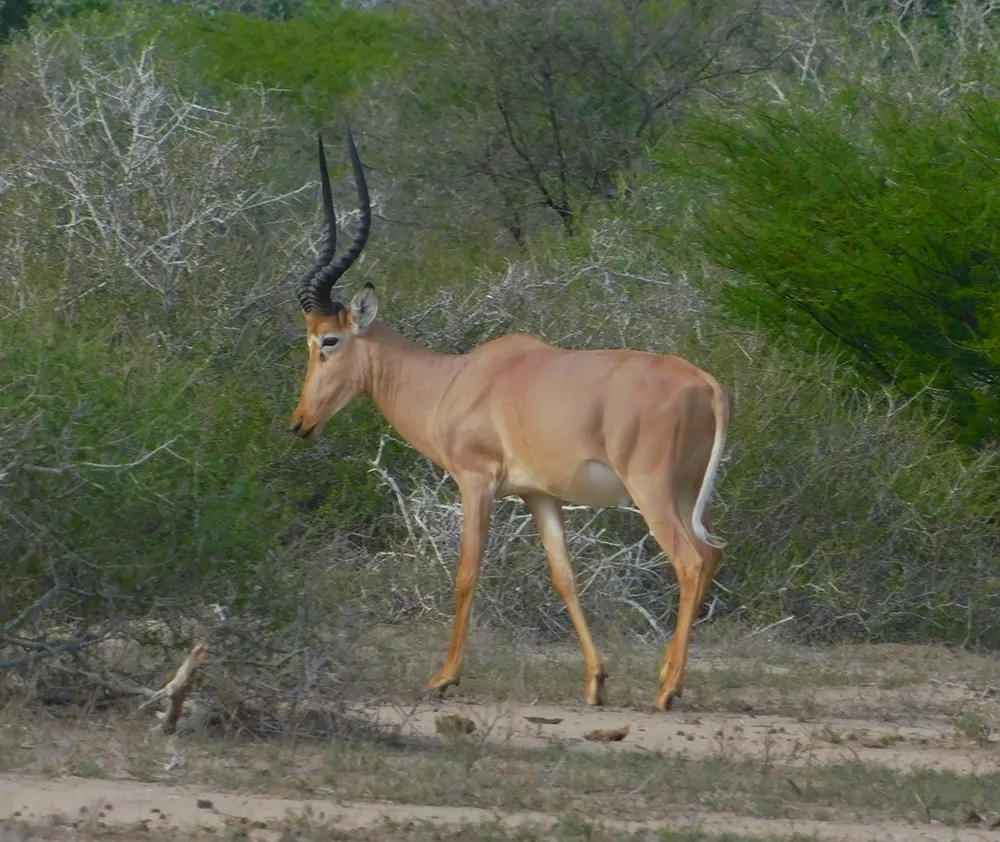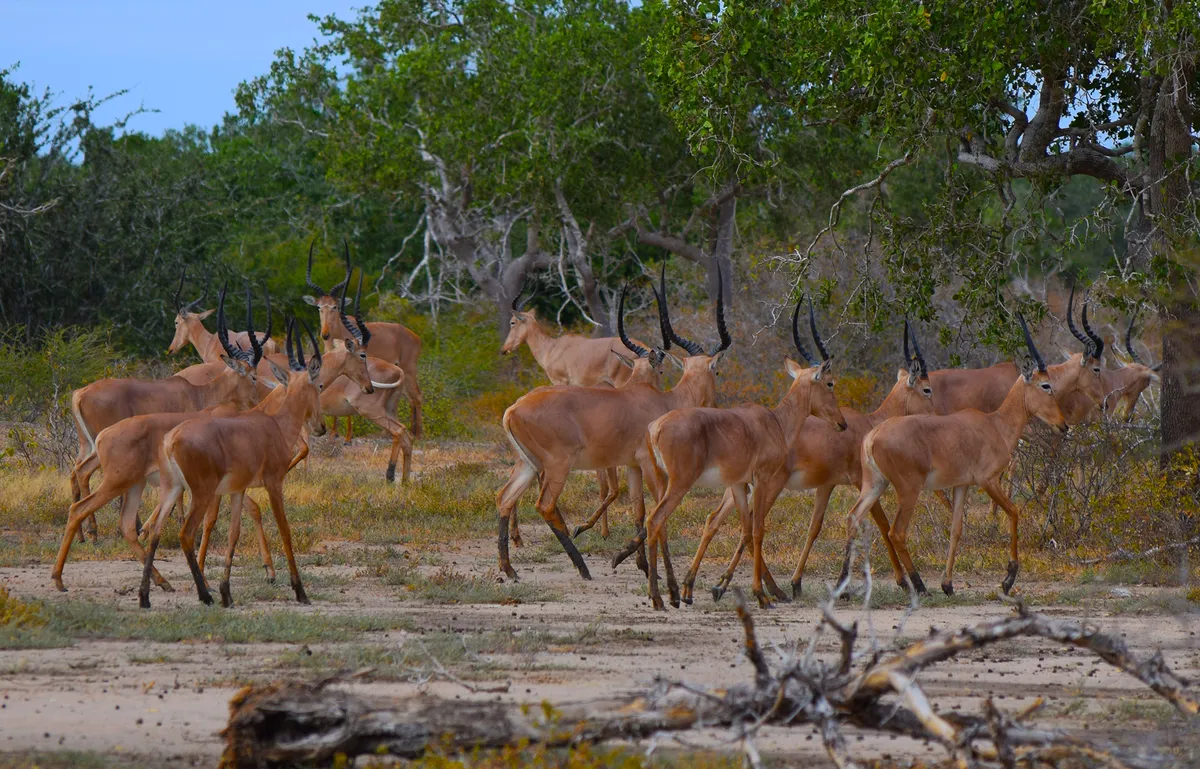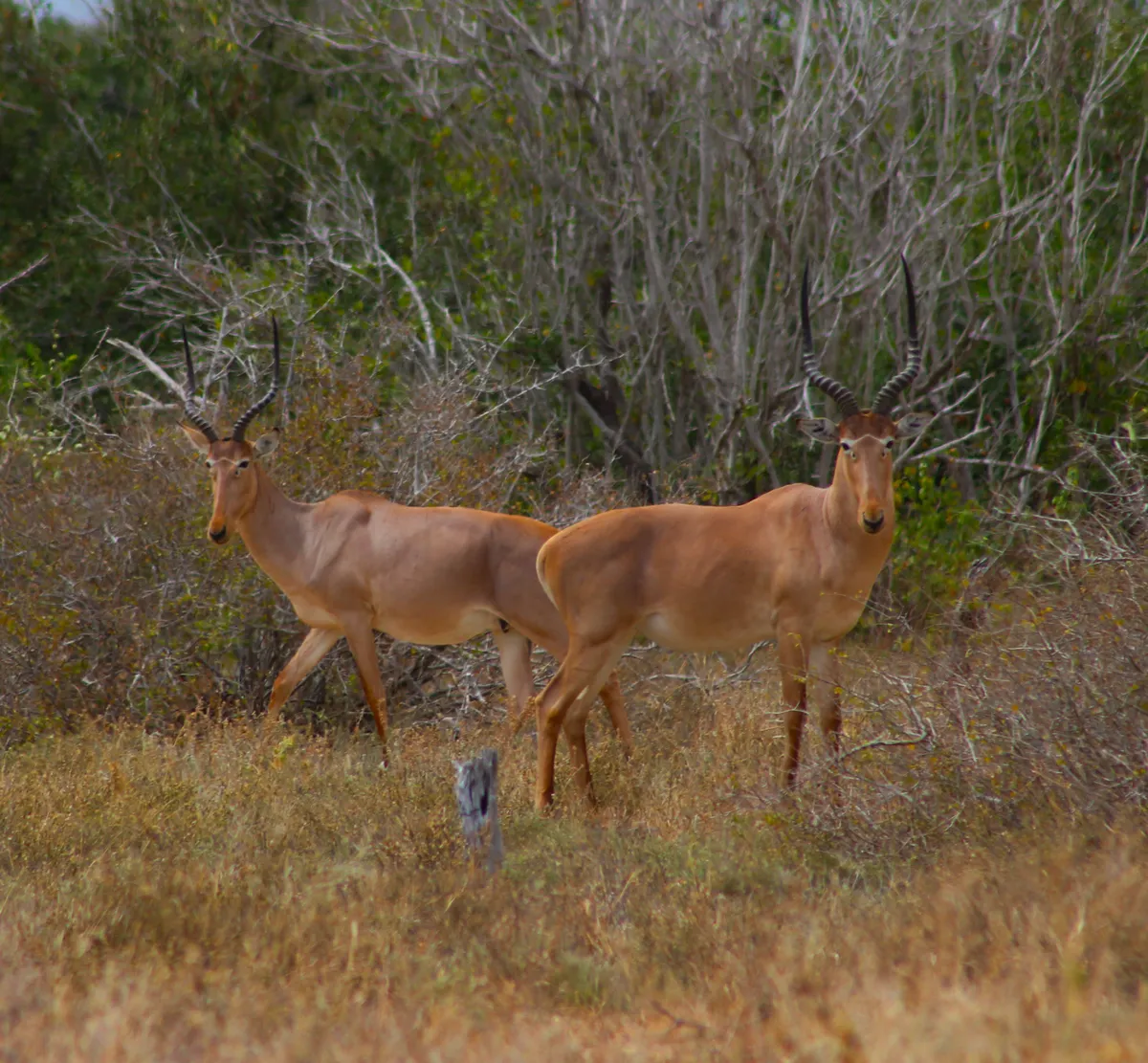In our expert hirola guide, discover more about the world's most endangered antelope, and what's being done to save it.
What are hirolas?
Hirolas are antelopes belonging to the family Bovidae (hoofed mammals) that includes buffalo, cattle, goats, and sheep among others.
They are medium sized slender antelopes weighing between 80 and 118k, and have a body length of between 1.2 and 2 m, and a tail length between 10 and 60 cm.
Hirola have unusually shaped facial markings i.e. the distinctive inverted white ‘chevron’ between the eyes with white "spectacles" around the eyes and white ears with black helix (ear tip). Their coat is yellowish-brown with a pale underside. In some instances, males have been observed to have a grey coloration.
Hirola have dark thick lyre-shaped horns with bold, conspicuous rings. These horns can measure up to 28 inches (70 cm) in length. Both adult males and females have these well-developed lyre-shaped horns.
How was the hirola named?
The name hirola comes from the Somali name ‘Arawla’ which refers to their rufous-tawny coat colour. It is also named the 'Hunter’s antelope' after a big game hunter who described it in 1887.
Hirolas are scientifically known as the Beatragus hunteri, and are the only extant member of the genus Beatragus, which is 1 of 4 genera in the Alcelpahinae subfamily. Other English names include Hunter’s hartebeest and four eyed antelope.
Why do hirola have four eyes?
Hirolas' huge pre-orbital glands beneath their eyes resemble spectacles giving the impression that they have four eyes. This has also led to them being referred to as the four eyed antelope. These glands are used to mark their territories and make hirola highly recognisable by their facial appearance.

Where are hirolas found?
Hirolas are restricted to communal lands along the southern part of the Kenya-Somali border. This natural population is the global majority and is found in Ijara, Bura and GalmaGalla locations in Garissa County, Kenya.
There is also a small translocated population in Tsavo East National Park, outside the species natural range. This population was translocated from Garissa District in 1963 and 1996 as an insurance in-situ population.
Have hirolas experienced population decline over the years?
The hirola population has declined by over 95% in the last four decades. They have experienced a consistent decline since the 1970s from approximately 15,000 individuals to less than 500 individuals currently.
There are currently less than 500 hirola individuals in the world, with all occurring in the wild. There are no hirolas in captivity.

Why have hirolas declined?
The initial decline of hirolas was linked to a rinderpest epidemic in the 1980s. This viral disease wiped out between 85% to 90% of the 15,000 hirolas existing at that period.
A few years later, rinderpest was eradicated but the hirola population did not recover. More recent findings identify rangeland degradation as the ultimate driver of hirola declines.
Hirola are a grassland species preferring habitat with less than 30% tree cover. However, tree cover has increased by over 250% in the last three decades leading to loss of both food and space for hirola and restricting them to less than 5% of its native range.
This, and a combination of other factors including, predation and competition with livestock have continued to suppress the recovery of hirola.
What do hirolas feed on?
Hirolas are core grazers with selective feeding habits. They only feed on short, newly sprouted grass. They also feed on grasses and forbs (a type of a herbaceous flowering plant) which allow them to go for long periods without water.
They are active during the day with most grazing activity happening in the mornings and evenings.

What are some of the hirolas' predators?
Hirola predators include large carnivores such as lions, cheetahs, the African wild dog, and humans. Hyenas and eagles have also been observed to prey upon young hirola shortly after they are born, before the calf and its mother rejoin the herd.
How do male hirolas interact?
When hirola males fight, they always attempt to remain on all of their four legs, as opposed to falling to their knees in a critical fight when protecting their territory and their females.
What habitats are hirolas found in?
Hirolas prefer open grasslands with light bush to wooded savannahs with scattered trees and low shrubs; often occurring on sandy soils. They are adapted to arid environments with an annual rainfall of 300 to 600mm.
Despite the arid environments they occupy, hirolas appear to survive without access to surface water.
What conservation efforts are being undertaken to improve hirola numbers?
In late 2005, four local communities within Ijara District, developed and put forward a proposal to formally establish the Ishaqbini Hirola Conservancy for the in-situ protection of hirola.
In 2012, and in an attempt to curtail further hirola declines, the Ishaqbini Community Conservancy, the Northern Rangelands Trust and Kenya Wildlife Service established a 25km2 livestock-free and predator-proof sanctuary to breed hirola and then reintroduce them to the wild within their historic range in eastern Kenya
The Hirola Conservation Program (HCP) in partnership with local communities is spearheading the protection of over 1 million acres of new critical hirola habitat, and has partnered with county government of Garissa to restore Arawale National reserve which collapsed in the 1980s.
In addition, HCP is restoring hundreds of hectares of grasslands for hirola. These restoration efforts aim at restoring grasslands in areas where hirola persist currently as well as future reintroduction sites through bush clearing, grass reseeding and fertilisation.
HCP is also working with the community to provide community-based protection of elephants (in the form of anti-poaching squads and enhanced communication between villages) to encourage elephant herds to reside on community lands. This will in the long-term help control increasing tree cover that is threatening the survival of hirola.

Main image: Hirola. © Hirola Conservation Program

